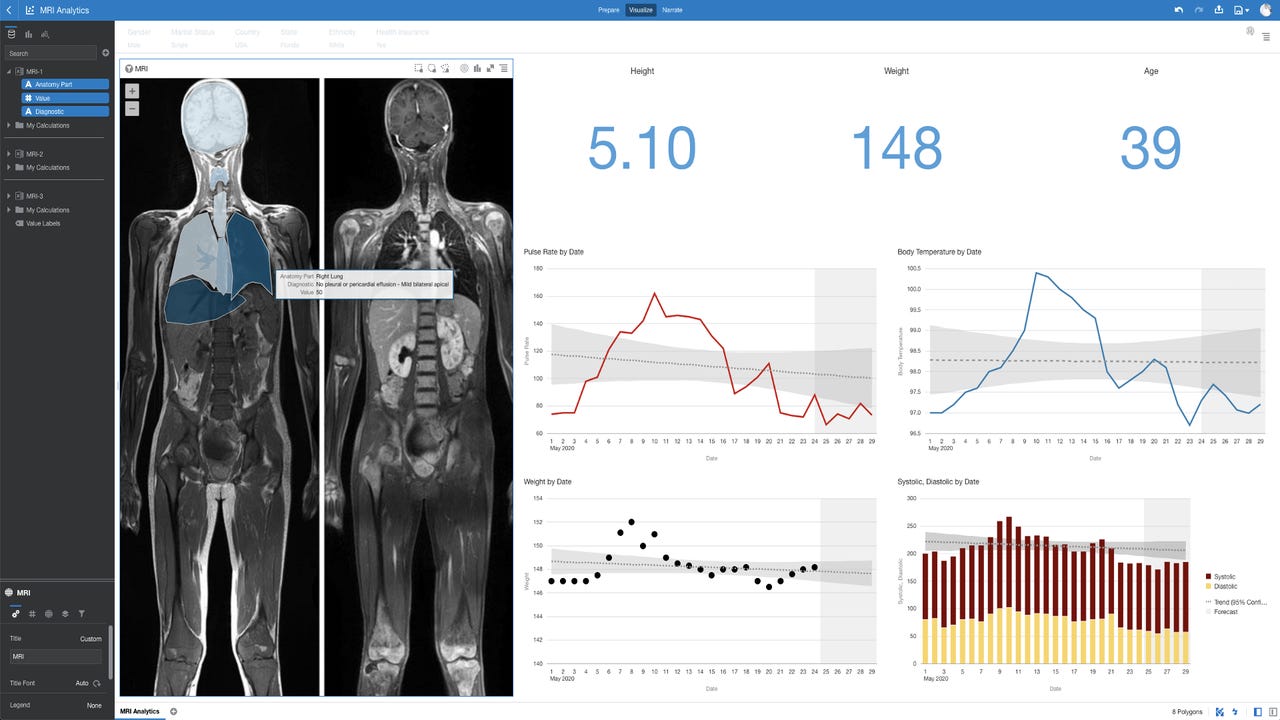Oracle updates its Analytics Cloud


OAC Custom Map Analytics used in an MRI analytics dashboard, with human body images as map layers
As part of its Oracle Live continued virtual events series this morning, the Austin, TX- (and formerly Redwood City, CA-) based database and enterprise analytics giant is announcing a number of new and recently-added features to its cloud-based business intelligence (BI) offering, Oracle Analytics Cloud (OAC). First announced 2 years ago, OAC is a cloudified, unified offering of Oracle's entire BI portfolio. OAC's cousins, Oracle Analytics Server (OAS) and Oracle Fusion Analytics Warehouse, offer corresponding on-premises and application-based platforms, with OAC as the standalone, cloud-based offering.
Also read:
- Oracle Analytics: Honing 18+ products down to a single brand
- Oracle rolls out Analytics for Fusion ERP
- Oracle Analytics revamp continues with Analytics for Cloud HCM
High-level
For extra context, ZDNet spoke last week with Oracle's T.K. Anand, Senior Vice President for Analytics and Joey Fitts, Vice President, Analytics Product Strategy. The two explained that OAC, like other cloud platforms, has a steady stream of new features added, rather than bringing "big bang" releases to market. Still, the company likes, on a periodic basis, to announce explicitly features that have recently been added, along with features to come in the current calendar month and those which will be added afterwards, but still in the near future. This morning's announcements are one such periodic batch.
The features being announced today are thematically tied around bringing enterprise, self-service, and augmented analytics (including automated machine learning -- AutoML) together. In addition, in the next few months, the components in the OAC platform will be undergoing a user interface refresh based on Oracle's "Redwood" design standards.
Features galore
New OAC user-oriented features include:
- Oracle Analytics Mobile, a mobile BI app for analytics consumption use cases, to be available for iOS and Android (see image of the iOS version below). This app joins Oracle's "Day by Day," a separate app that facilitates BI collaboration, and provides a social media-like analytics feed
- An infographics/data stories feature designed for true BI presentations that don't look like reports or dashboards
The Oracle Analytics Mobile app on an iPhone
Features for technical users are being added to OAC as well. These include:
- Automated Data Preparation, a data engineering facility feature that, with the help of AI, will make suggestions on common tasks like cleansing, obfuscating, and geocoding data. The feature is built on an underlying knowledge base that is also extensible, allowing -- for example -- customers to add their own product catalog, or other custom reference knowledge
- A Data Flow feature which can consume data from sources, perform transformations on it and then push the results in OAC, databases and data warehouses. "Transformations" is a broad term here, as it even includes training new machine learning (ML) models, or doing bulk scoring against existing ML models, on the incoming data
- ML Explainability, which provides a user-oriented experience to provide background context on individual predictions, including the feature (input) values that were most influential
- Graph Analytics features, including functions like page rank, closest neighbor, and more. These can be used standalone or invoked from a Data Flow as well
- Text Analytics that can, for example, perform token extraction or sentiment analysis on a specific text field, with the option to render word clouds
- Also being announced: Affinity Analysis (which, for example, works well for Market Basket analytics); Custom Map Analytics (custom images as map backgrounds and creation of map layers to enhance data visualizations -- see image at top of this post); and Natural Language Processing (search-based querying and generation of results in narrative form, supporting 28 languages)
All in the family
Oracle has been working earnestly on its revamped analytics offering for about two years now. Its appeal may be greatest for existing customers of Oracle's applications, database, applications and its cloud. Clearly, the company is not trying to compete with the Tableaus and Power BIs of the world, as Salesforce, Microsoft and, to some extent, Google have that self-service and visualization-oriented BI market well-in-hand.
But Oracle Analytics has enterprise chops, a long history and the option for out-of-the-box data pipelines and data models for Oracle applications. Today's announcements continue to keep the platform in play as a competitive offering for customers who can benefit strongly from that tight integration with other Oracle software and services.
Edited May 5th, 2021 at 9:50pm ET to update the name of Oracle Analytics for Applications to Oracle Fusion Analytics Warehouse